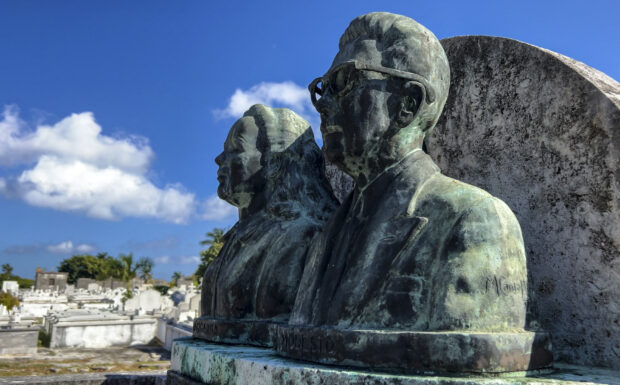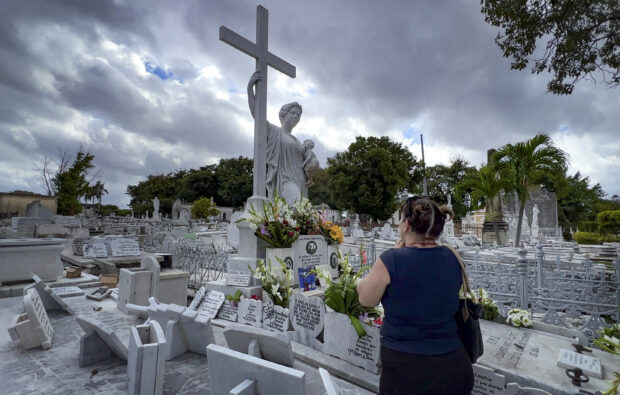The lovers who left their heart in Havana cemetery

The bronze busts of the tomb of the couple Margarita Pacheco and Modesto Canto, known as “The Tomb of Love,” are pictured at Colon Cemetery in Havana on February 12, 2024. With its elaborate sculptures and architecture, the cemetery is considered an open-air museum, housing the final remains of independence heroes, writers, musicians, painters, and famous doctors. But it is also a place where loves—some shocking, some hidden, some thwarted—are immortalized. AFP
HAVANA — Cuban sugar magnate Juan Pedro Baro spared no expense when it came to building the immense marble tomb of his one true love in Havana’s Colon cemetery, an unlikely repository of past passions.
Baro’s adulterous romance with one of Cuba’s most beautiful women, Cataline Lasa, who died in 1930, scandalized high society, but lives on in the luxurious touches of her Art Deco mausoleum.
“The cemetery is full of love stories,” said Mario Darias, a 66-year-old singer-songwriter who has written several books about the Havana graveyard, founded in 1876 and which extends over around 50 hectares (120 acres) in the heart of the city.
With its elaborate sculptures and architecture, the cemetery is considered an open-air museum, housing the final remains of independence heroes, writers, musicians, painters and famous doctors.
READ: Valentine’s Day meets Ash Wednesday: Navigating love amid penance
Article continues after this advertisementBut it is also a place where loves — some shocking, some hidden, some thwarted — are immortalized.
Article continues after this advertisementLasa’s tomb represents one of Cuba’s most famous love stories.
The upper-class beauty was married to the son of Cuba’s vice president when she met and fell in love with Baro.
“High society took sides in this matter and turned their backs on them,” explained Darias.
The two lovers fled to Paris where they lived until 1917, when Pope Benedict XV granted their request to have Lasa’s marriage annulled.
The pair returned to Havana where they lived until Lasa fell ill and died aged 55.
Her mausoleum, currently under restoration, is made of white marble and black granite, and topped with glass roses made by French glassmaker Rene Lalique, who died in 1945.
A scandalous age difference
Elsewhere lies the tomb of another pair of lovers who raised eyebrows in their time, a teacher and student with a 30-year age difference.
Modesto Canto (1890-1977) is buried alongside his much younger wife Margarita Pacheco (1920-1959) in a tomb bearing the sculptured busts of the pair and the phrase “united by eternal love.”
“Many people were opposed to their relationship. Everyone said she was going to be widowed very soon, but she died first,” said Darias.
Not far away stands the tomb of Amelia Goyri who died while eight months pregnant at the age of 24 in 1901, and was buried with her baby atop her legs, as was the custom.

Leticia Mojarrieta, 56, visits the grave of Amelia Goyri (a.k.a. La Milagrosa) to requests personal wishes at Colon Cemetery in Havana on February 12, 2024. With its elaborate sculptures and architecture, the cemetery is considered an open-air museum, housing the final remains of independence heroes, writers, musicians, painters, and famous doctors. But it is also a place where loves—some shocking, some hidden, some thwarted—are immortalized. AFP
Her bereaved husband began a dedication to her tomb so intense that its emotion was contagious, and visitors to the cemetery began stopping to pay their respects to her as well.
A two-meter-high white marble statue of her was erected, but it was in 1914 that a myth was born and she earned her nickname “La Milagrosa,” the miraculous one.
READ: Remember a departed loved one this Valentine’s Day
When her tomb was opened that year, she is reported to have been found intact, with her baby in her arms.
Since then Cubans have flocked to her tomb to leave offerings and wish for luck, whether to conceive or protect a child, for health, or a school exam.
Leticia Mojarrieta, 56, knows this love story and complies with the ritual of never turning one’s back on the sculpture — which Goyri’s husband used to do during four decades of visits to her grave.
She is asking for protection for her daughter-in-law, who is pregnant and has just emigrated to the United States.
“We detected a little liquid in the baby’s chest. I came to ask for help” from La Milagrosa, she told AFP.